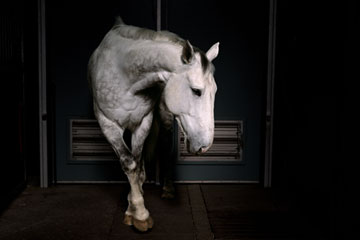
Horses can lapse into apparent depression when they lose a companion.
(5 of 6)
To the extent that it's possible to suss out scientifically what's going on in animals' heads at moments like these, preliminary evidence suggests that it's a grief response. Stress--including the kind that follows a death--leads to the release of the hormone cortisol in animals and humans; cortisol, in turn, can trigger the release of oxytocin, often called "the cuddle chemical." It's oxytocin that spikes in parents after a baby is born and nudges all of us in subtler ways to seek social connections and affiliation.
Primate investigator Anne Engh followed baboons in Botswana to determine how they reacted to one of the most traumatic events an animal community may experience: the killing of one of their own by a predator. After an attack, she would collect fecal samples from members of the troop and look for signs of increased glucocorticoid (GC) stress markers. For up to a month, GC was elevated in all the individuals she tested that had witnessed the killing but was higher still in the 22 that had close family or social connections to the victim. If this led to oxytocin release, the animals would be pushed to engage in the same kind of curative gathering we practice after a death. It's stress plus grieving with a purpose--exactly how the system is supposed to work.
"Even though they may not be aware of the responses, the responses are adaptive," says University of Pennsylvania biologist Dorothy Cheney, co-author of Baboon Metaphysics and one of the researchers who oversaw Engh's work. "As with people, animals with strong social-support networks are buffered against the effects of stress."
Brain studies strengthen the case for animal grief. In humans, mourning is mediated by the frontal cortex, the nucleus accumbens and the amygdala, a deeply seated structure that processes emotions. We share that basic anatomy with many other animals, though in some species the structures are poorly developed. Birds' brains don't parallel ours closely, but they do have an amygdala, and crows in particular have a large forebrain and a well-developed hippocampus, which processes memory.
Marzluff has conducted studies in which crows are captured by a researcher wearing a mask and then fed and cared for by someone wearing a different mask. Later the birds are injected with a radioactive dye and shown either the capture mask, which has stressful associations; the feeding mask, which has pleasant ones; or a third mask they've never seen, which has no associations at all. The birds are then anesthetized and placed in a PET scanner, which reads the location of the dye in the brain.
Consistently, the crows looking at the scary mask have higher amygdala activation than the others. When the experiment is repeated but they are shown a taxidermied crow that appears to be dead, activation occurs in the hippocampus instead, suggesting that they're forming a location memory that says, effectively, This is a dangerous place; avoid it. What Marzluff would like to determine is whether crows would show emotion-laden amygdala activation as well as hippocampus activation if the dead animal they were looking at were an offspring or a mate.
